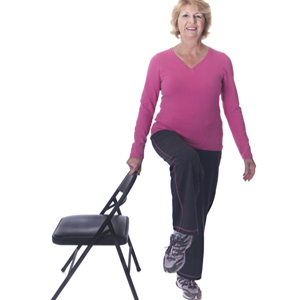FitnessLifestyle: Giving Seniors a Leg Up

Maintaining strong legs becomes important as we age, because it improves the quality of life by making daily activities—climbing stairs, getting in and out of cars, even simply standing up—more manageable.
Strength training or weight bearing exercises for legs is of particular importance to seniors. As we age, we lose a certain percentage of muscle mass each year if we are not actively performing strength training exercises. According to the Centers for Disease Control and Prevention, “roughly more than one-third of adults ages 65 years and older fall each year.” These falls often lead to further complications such as fractures and are the leading cause of injury-related deaths among older adults. Falls can be a result of many issues: loss of strength, dizziness resulting from old age, side effect of medications, muscle loss due to ageing, and/or hazards in the environment. Having strong legs can not only prevent a fall but also aid in recovery from a fall.
While walking is a good cardiovascular exercise and an activity most seniors are comfortable with doing, it does not provide the benefits of strength training. An effective strength training routine should include exercises for all the basic major muscles of the lower body, as listed below.
Here are some exercises that seniors can safely perform at home to strengthen each of these muscles.
The quadriceps muscles (front of the thigh): Standing next to a chair and holding on to it for balance, extend one leg forward slowly and hold for a couple of seconds. Lower the leg, relax for a few seconds and repeat up to ten times, and then switch and perform with the other leg. Keep the movement slow and controlled without jerking. This exercise can also be done seated on a chair. While seated, extend the leg so that it is parallel to the ground without locking the knee. Hold for a few seconds, lower the leg and repeat.
The hamstring (back of the thigh) and gluteus (buttocks) muscles: Standing behind a chair and holding on with both hands for balance, extend one leg back without leaning forward, keeping good posture. Hold this position for a couple of seconds and lower. Repeat up to ten times and switch to the other leg. This exercise can also be performed with the knee bent behind at a right angle.
The abductor muscles (outer thigh): Standing behind the chair with shoulders back, lift one leg out to the side, hold and lower to start position. Repeat several times and switch to the other leg.
The adductor muscles (inner thigh): Stand next to a chair and with the hand closest to the chair hold on for balance. Lift the opposite leg with toes pointing away from the chair and bring it across the front of your body several inches off the ground. Hold for a couple of seconds and lower to start position. Repeat up to ten times and switch and perform with the other leg.
The calf muscles: Standing behind the chair and holding on with both hands while maintaining good posture, slowly lift the heels off the ground, shifting weight to the balls of the feet. Hold for a couple of seconds and lower. Repeat up to ten times. Begin without adding any ankle weights, but for an additional challenge, one to two pound (no more than that) ankle weights can be added depending on your level of fitness.
These exercises should be performed two to three times a week after a walk so that the body is warmed up. Finally, if you have existing issues with the knees or the lower back, it is always best to check with your health care provider before beginning any exercise.
[Aarti Patel serves as the columnist for Fitness Lifestyle. She has a B.Sc. in Health Information Administration and is certified by the American Council on Exercise as a Personal and Group
Fitness Instructor, and Lifestyle and Weight
Management Coach. She can be reached at
(404)-376-5655; info@aartifitness.com.
This
column rotates monthly along with the Ask the Doctor column by Gulshan Harjee, M.D.]
Enjoyed reading Khabar magazine? Subscribe to Khabar and get a full digital copy of this Indian-American community magazine.
blog comments powered by Disqus










